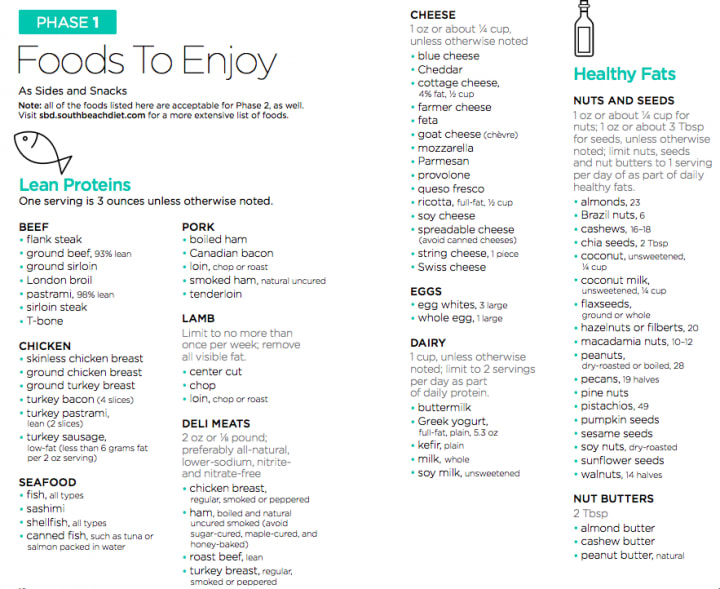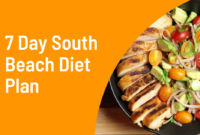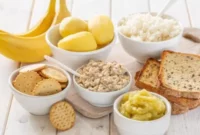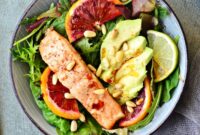South Beach Phase 2 food list: Navigating this phase of the South Beach Diet requires careful attention to permitted foods. This guide provides a comprehensive overview of allowed and prohibited foods, offering sample meal plans, recipes, and snack ideas to ensure you stay on track and enjoy delicious, healthy meals throughout your journey. We’ll explore the rationale behind the dietary restrictions, offering insights into the science supporting this popular weight-loss plan. Understanding the nuances of Phase 2 is key to success, and this resource aims to make that understanding straightforward and accessible.
From breakfast options like egg scrambles with spinach and feta to satisfying dinners featuring lean proteins and plenty of vegetables, we cover a range of meal possibilities. We also delve into smart snacking strategies, ensuring you stay energized and avoid cravings. This guide goes beyond simply listing permitted foods; it equips you with the knowledge and tools to create a sustainable and enjoyable eating plan tailored to Phase 2 guidelines.
Understanding “South Beach Phase 2” Dietary Restrictions
South Beach Diet Phase 2 builds upon the initial restrictions of Phase 1, gradually reintroducing certain foods while maintaining a focus on healthy fats, lean proteins, and complex carbohydrates. This phase is designed to promote sustainable weight loss and improve overall health by teaching mindful eating habits and establishing a balanced dietary pattern. Understanding the specific limitations and permitted food groups is crucial for successful adherence to the plan.
Phase 2 of the South Beach Diet restricts certain foods to encourage weight loss and improved metabolic health. The rationale behind these restrictions centers on minimizing rapid blood sugar spikes and promoting satiety through nutrient-rich choices. By limiting processed foods, refined sugars, and unhealthy fats, the diet aims to regulate insulin levels, reduce cravings, and foster a feeling of fullness that supports weight management.
Permitted Food Groups in South Beach Phase 2
Phase 2 expands the food choices available compared to Phase 1. The permitted food groups offer a wider variety of options while maintaining the core principles of the diet. This allows for greater meal planning flexibility and helps prevent diet fatigue.
- Lean proteins: Chicken breast, fish (salmon, tuna, etc.), lean beef, turkey, beans, lentils.
- Healthy fats: Olive oil, avocados, nuts (in moderation), seeds.
- Complex carbohydrates: Whole grains (brown rice, quinoa, whole-wheat bread in moderation), vegetables (broccoli, spinach, asparagus, etc.), fruits (berries, apples, pears, etc., in moderation).
- Dairy (in moderation): Low-fat or fat-free yogurt, skim milk (choose options without added sugar).
Prohibited Foods in South Beach Phase 2
While Phase 2 introduces more food choices, several items remain restricted to maintain the diet’s effectiveness. Understanding these limitations is essential for staying on track.
| Allowed Foods | Prohibited Foods |
|---|---|
| Lean meats (chicken breast, fish) | Processed meats (bacon, sausage, hot dogs) |
| Whole grains (brown rice, quinoa) | White bread, pastries, white rice |
| Non-starchy vegetables (broccoli, spinach) | Potatoes, corn, peas (high-starch vegetables) |
| Fruits (berries, apples) – in moderation | Sugary drinks (soda, juice), candy, desserts |
Phase 2 Food List
South Beach Diet Phase 2 expands the food choices available compared to Phase 1, allowing for the reintroduction of certain healthy fats and a wider variety of vegetables and proteins. This phase focuses on continued weight loss while maintaining a balanced nutritional intake. The following sections detail suitable lunch and dinner options, providing recipe ideas and a sample weekly meal plan.
Phase 2 Lunch Options
Choosing healthy and satisfying lunches during Phase 2 is crucial for maintaining energy levels and staying on track with your weight loss goals. The following options provide a variety of flavors and textures while adhering to the dietary restrictions.
- Mediterranean Quinoa Salad: A vibrant mix of cooked quinoa, chopped cucumber, tomatoes, red onion, Kalamata olives, and crumbled feta cheese, dressed with a lemon-herb vinaigrette. This offers a good balance of protein, fiber, and healthy fats.
- Tuna Salad Lettuce Wraps: Mix canned tuna (in water) with avocado, celery, and a touch of Dijon mustard. Serve in crisp lettuce cups for a low-carb, high-protein option.
- Chicken and Vegetable Skewers: Grilled chicken breast chunks marinated in herbs and spices, alternated on skewers with bell peppers, zucchini, and cherry tomatoes. This provides lean protein and plenty of vitamins.
- Large Salad with Grilled Salmon: A bed of mixed greens topped with grilled salmon, a variety of colorful vegetables (such as spinach, carrots, and broccoli), and a light vinaigrette. This offers a great source of omega-3 fatty acids and protein.
- Leftover Dinner: Repurposing dinner leftovers for lunch is a convenient and time-saving strategy. Many Phase 2 dinner recipes can be easily adapted for lunch.
Phase 2 Dinner Recipes
Dinner provides an opportunity to enjoy more substantial meals while staying within the Phase 2 guidelines. These recipes offer a variety of flavors and nutritional benefits.
- Baked Salmon with Asparagus: Season salmon fillets with herbs and lemon juice, then bake alongside asparagus spears drizzled with olive oil. This is a simple yet elegant meal rich in omega-3 fatty acids and fiber.
- Chicken Stir-fry with Brown Rice: Stir-fry chicken breast with a medley of colorful vegetables (broccoli, carrots, snap peas) in a light soy sauce-based stir-fry sauce. Serve over a small portion of brown rice.
- Shrimp Scampi with Zucchini Noodles: Sauté shrimp with garlic, white wine, and lemon juice. Serve over zucchini noodles (zoodles) for a low-carb, high-protein meal.
- Lean Ground Turkey Chili: A hearty chili made with lean ground turkey, beans (kidney, black, or pinto), diced tomatoes, onions, and chili powder. This is a flavorful and filling option packed with protein and fiber.
- Sheet Pan Chicken and Veggies: Toss chicken breast and chopped vegetables (such as broccoli, Brussels sprouts, and sweet potatoes) with olive oil, herbs, and spices. Roast on a sheet pan for an easy and healthy meal.
Nutritional Comparison of Two Dinner Recipes
Let’s compare the Baked Salmon with Asparagus and the Lean Ground Turkey Chili. The salmon dish is higher in omega-3 fatty acids, which are beneficial for heart health, while the chili offers a greater source of fiber, contributing to digestive health and satiety. Both are excellent sources of protein, but the chili provides more diverse micronutrients due to the inclusion of beans and various vegetables. The salmon is lower in carbohydrates, making it a better choice for those strictly managing their carbohydrate intake.
Weekly Meal Plan
This sample meal plan incorporates the lunch and dinner options discussed above, providing a balanced and varied diet throughout the week. Remember to adjust portion sizes based on your individual caloric needs.
| Day | Lunch | Dinner |
|---|---|---|
| Monday | Mediterranean Quinoa Salad | Baked Salmon with Asparagus |
| Tuesday | Tuna Salad Lettuce Wraps | Chicken Stir-fry with Brown Rice |
| Wednesday | Chicken and Vegetable Skewers | Shrimp Scampi with Zucchini Noodles |
| Thursday | Large Salad with Grilled Salmon | Lean Ground Turkey Chili |
| Friday | Leftover Chili | Sheet Pan Chicken and Veggies |
| Saturday | Mediterranean Quinoa Salad | Baked Salmon with Asparagus |
| Sunday | Leftover Chicken and Veggies | Chicken Stir-fry with Brown Rice |
Visual Representation of Phase 2 Foods
South Beach Phase 2 emphasizes a vibrant array of nutrient-rich foods. Understanding their visual characteristics helps in choosing and preparing meals that adhere to the dietary guidelines. The overall aesthetic is one of freshness and natural color, reflecting the emphasis on unprocessed ingredients.
The visual appeal of Phase 2 foods is largely defined by their natural state. Think bright, fresh colors and varied textures. Avoidance of processed foods means a significant reduction in artificial colors and overly uniform textures.
A Typical Phase 2 Plate
A well-balanced Phase 2 plate is a colorful and varied landscape. Imagine approximately half the plate filled with a generous portion of non-starchy vegetables. These could include vibrant green broccoli florets, the deep orange of carrots, or the bright red of bell peppers. Their textures would range from the crisp snap of raw vegetables to the slightly softer texture of steamed or roasted options. A quarter of the plate would be dedicated to a lean protein source. This might be a piece of grilled salmon, its flesh a delicate pink, or a portion of chicken breast, showcasing its pale, slightly fibrous texture. The remaining quarter of the plate would be filled with a small serving of healthy fats and a complex carbohydrate. This could be a small handful of almonds, their appearance a mix of creamy off-white and light brown, or a serving of quinoa, its grains small and pearly white. The overall visual effect should be one of balance and variety, showcasing the natural colors and textures of whole, unprocessed foods.
Conclusive Thoughts
Successfully navigating the South Beach Diet Phase 2 hinges on understanding the permitted foods and incorporating them creatively into your daily meals. This guide has provided a comprehensive resource, encompassing meal planning, recipe ideas, and snack suggestions, all aligned with Phase 2 restrictions. By understanding the rationale behind these restrictions and utilizing the provided tools, you can confidently embark on this phase of your weight-loss journey, enjoying delicious and nutritious food while achieving your health goals. Remember to consult your doctor or a registered dietitian before starting any new diet.




